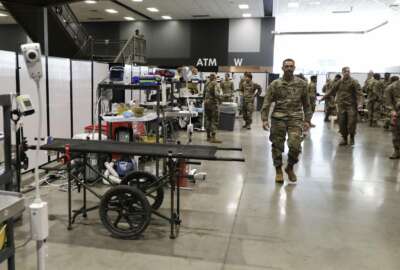
How much has the Pentagon spent on PPE over the last few years?
Analysts at Govini have dissected the trends in PPE spending by the military since 2013.
Best listening experience is on Chrome, Firefox or Safari. Subscribe to Federal Drive’s daily audio interviews on Apple Podcasts or PodcastOne.
For months now, health care, food inspection, first responders and the military have been scrambling for personal protective equipment (PPE). From gowns, face masks and face shields to overalls — it’s more Tyvek than a new housing development. Analysts at Govini have dissected the trends in PPE spending by the military since 2013. To understand how the Defense Department can support civilian organizations while also covering its own people, Govini CEO Tara Murphy Dougherty joined Federal Drive with Tom Temin.
Interview transcript:
Tom Temin: Ms. Dougherty, good to have you back.
Tara Murphy Dougherty: Thanks so much Tom.
Tom Temin: What were you looking at here? Going back to 2013, is this something that the military normally spends lots of money on?
Tara Murphy Dougherty: It’s not typically something that the military spends a lot of money on. We did an analysis, as you mentioned, of DoD spending on personal protective equipment over a seven-year period, in order to get a sense of just how much DoD invests in this area, and the extent to which they’re planning for a contingency like a pandemic or responding to it. And what we found is that typically the posture they’re in is a responsive one, which frankly probably makes sense given the Defense mission and the range of contingencies they’re planning for. But the numbers themselves were really interesting.
Tom Temin: Well, what was interesting? It looks like from your chart that Govini has published that there was a big spike in spending on PPE during the Ebola outbreak.
Tara Murphy Dougherty: Exactly. So this is a relatively recent case, if you recall Ebola took place about 2014 to 2016 – in that timeframe. And in particular, the United States led a humanitarian mission to West Africa to contain the Ebola outbreak in fall of 2014. We saw that over the following fiscal year of 2015, Defense spending on PPE surged to $40 million, which is only interesting if you think about it in the context of the earlier years of spending. It was nearly triple the amount of money that Defense spent on similar products in fiscal year 2014. And it was five times more than that in fiscal year ’13.
Tom Temin: So basically, they spend on a reactive basis, as you mentioned, they don’t really stockpile this stuff?
Tara Murphy Dougherty: Exactly. You know, what DoD is thinking about when it comes to stockpiling or equipment that – responsive to cases of war or military contingencies. And while they are certainly thinking about protecting the troops under all scenarios, as we saw, one of the data points that I thought was fascinating, and one of the things that I think is so compelling about data analytics in general, is we were able to show that over fiscal years ’13 to fiscal year ’19 the Defense Department spent over $2 million on hand sanitizer, which is sort of a phenomenal data point itself. I think the interesting aspect of this, Tom, is less whether a reactive posture is right or wrong, but the extent to which the Defense Department wants to plan for contingencies that aren’t a core military mission. For sure the Department of Defense provides support to civil authorities. And that is part of its mandate and an important one. But the extent to which it spends money on those types of activities, as opposed to other activities that are prioritized in the national defense strategy, and other defense strategic and policy guidance documents, is I think, the really interesting balance that the department has to grapple with. And what we find in periods of crisis like this are, it’s easy to look back and say, well, they should have planned more, they shouldn’t be reactive. Although for the past seven years, the Defense Department’s probably made the right choices in executing spending on PPE at the level that has.
Tom Temin: We’re speaking with Govini CEO Tara Murphy Dougherty. I guess the question then that would come up is who is spending it within DoD? Is it the National Guard, which might be called out by state officials to help in a local pandemic emergency – who is it?
Tara Murphy Dougherty: In the past period that we looked at nearly 90% of the PPE purchases were bought through the Defense Working Capital Fund, which is a revolving fund that increases the department’s acquisition flexibility. We saw the vast majority of that spent by the Defense Logistics Agency, which makes sense and now we’re seeing similar activities. You’ve probably seen Undersecretary of Defense Ellen Lord, who leads acquisition and sustainment. She’s been very communicative to the industry, to the public about defense activities, and she has, and her office has led the allocation of funds to also contractors. And the top 10 contractors account for nearly 90% of the kind of spending that’s happening in this space, which is as we would expect, and they are likely to be well positioned to surge in a contingency like this.
Tom Temin: What types of companies are these? These are not the same people that make weapon systems and uniforms, or are they?
Tara Murphy Dougherty: Some of them are. I think that these are the companies the Defense Department is typically going to for its other equipment. These are companies, the prime contractors the Defense Department has long standing relationships with and what we’re seeing is interesting trends around just how capable they are of surging in a situation where the civilian sector is impacted. And it raises interesting questions for the Defense Department around asking industry to surge in another kind of contingency. If you think about munitions for example, the Defense Department does not keep on hand all of the munitions that it would need to execute a protracted war. We know this, this is part of military planning. The expectation is the Defense Department could call on industry, much like it has through the Defense Production Act with COVID, in order to scale up production of those munitions. What we’re seeing in COVID is with a shutdown of a number of companies in the defense sector, that surge capacity may not actually be either present or as large as the Defense Department is planning for. So my hope is that this situation will, it certainly will provide lessons. My hope is that defense leaders will take those lessons and feed it into the other core contingencies the department is planning against.
Tom Temin: Is there something that civilian agencies could learn from the way Defense goes about the acquisition of personal protection gear, anything else?
Tara Murphy Dougherty: I think so. I think that, you know, one of the things that’s compelling about the Defense Department’s response in all of this is, this is essentially what they’re built to do. They’re built to operate in crisis and they’ve made some decisive moves and not on long timelines. So for example, one of the decisions that they made was to loosen restrictions on other transaction authorities or OTA contracts. And what that has done is it has pushed decision-making authority down to a lower level so that acquisition officials can move faster in making COVID-related purchases. That kind of nimbleness is hard to do in a large bureaucracy, of course, but it’s something that I think the Defense Department does well and the civilian sector can look to – I’m sorry, the civilian government agencies can look to the Defense Department with respect to that kind of decision making and emulate it.
Tom Temin: And for people that really like the details if they look at the visualization of the data that you have provided, it looks like gloves, I guess, rubber gloves or latex gloves, whatever they are, you know those gloves and come a lot like a Kleenex box. Those have been fairly steady throughout the year since 2013. The big spikes was in gowns, aprons and coveralls. And then that sank back down again until 2019. But it’s hard to tell what’s happening in 2020. Does that mean anything?
Tara Murphy Dougherty: Right, the data is still playing out for 2020. But I think that’s a great observation. We did see that spending on gloves over that seven-year period was close to $50 million and stayed fairly steady. I think because of the broad applicability of gloves in so many different settings, whether there are medical settings or scientific settings, as opposed to something like gowns where you saw a significant spike as part of that Ebola response. Gowns are much less relevant to the coronavirus response. And so we’re seeing instead huge spending coming out of DoD as well as the stimulus overall, on face masks in particular and in 2020 thus far as part of the COVID response, the Defense Department has spent over $200 million to surge that industrial capacity to produce and N95 facemasks.
Tom Temin: And do you think that the Defense activity has helped or hindered the commercial availability of these products?
Tara Murphy Dougherty: Oh, I think it hasn’t taken away from the commercial availability at all. A new fact we’ve seen the Defense Department knew to provide additional capacity and resources to civilians. And this goes in line with what we were talking about with respect to this report to civilian agencies’ mission that the Defense Department does maintain. They’ve stood up hospital ships, and we’ve seen calls to do more of that, among other types of responses with the National Guard and even local area responses. So I think it has been a creative to those efforts to be sure.
Tom Temin: Tara Murphy Dougherty is CEO at ovine. Thanks so much for joining me.
Tara Murphy Dougherty: Thank you, Tom.
Tom Temin: We’ll post this interview along with a link to the report at www.FederalNewsNetwork.com/FederalDrive. Hear the federal Drive on demand and on your device. Subscribe at Apple Podcasts or Podcastone.
Copyright © 2025 Federal News Network. All rights reserved. This website is not intended for users located within the European Economic Area.
Tom Temin is host of the Federal Drive and has been providing insight on federal technology and management issues for more than 30 years.
Follow @tteminWFED






